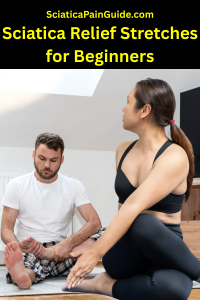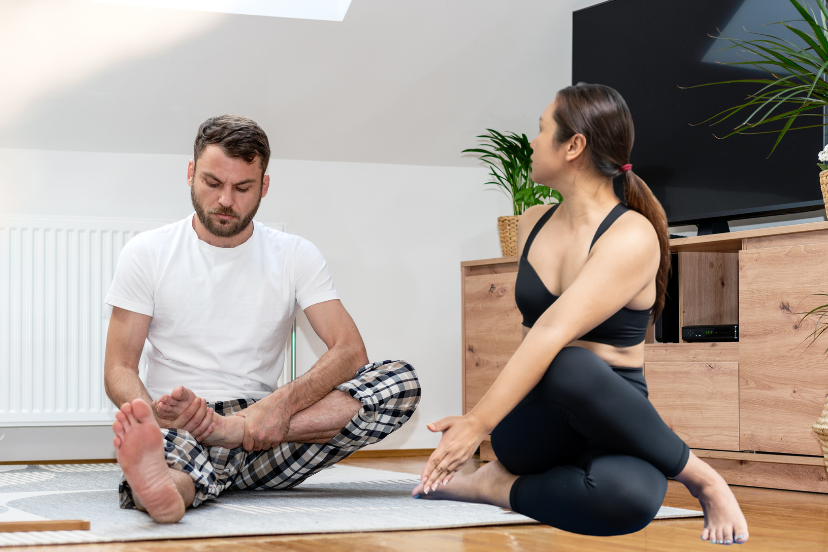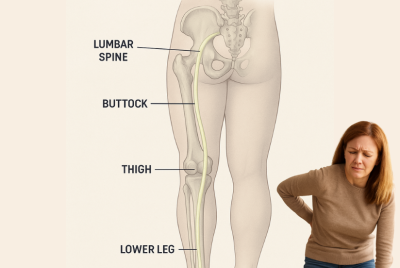Sciatica Relief Stretches for Beginners: Gentle Moves to Ease Pain
Finding Relief When Sciatica Strikes
If you’ve ever felt sharp pain radiating from your lower back down your leg, numbness in your foot, or the frustration of struggling to sit or walk, you’re not alone. Sciatica affects millions of Americans each year, and many are searching for simple, safe, and effective ways to find relief at home. One of the best starting points? Sciatica relief stretches for beginners. Gentle, low-impact stretches can ease pressure on the sciatic nerve, improve flexibility, and reduce flare-ups — even if you’ve never done regular exercise before.
In this guide, we’ll cover beginner-friendly stretches, yoga poses, and lifestyle tips to help you take control of your pain.
What Causes Sciatica Pain?
Sciatica isn’t a condition itself but a symptom caused by irritation or compression of the sciatic nerve. Common causes include:
-
Herniated or bulging discs in the lower spine
-
Spinal stenosis (narrowing of the spinal canal)
-
Piriformis syndrome, where a tight muscle irritates the nerve
-
Poor posture or prolonged sitting
-
Excess weight and weak core muscles
Understanding the root cause is important, but stretching can be a universal relief strategy because it reduces tension and improves blood flow to affected areas.
Why Start with Beginner Stretches?
Jumping into advanced workouts or high-intensity routines can worsen pain. Beginner stretches for sciatica relief are designed to be gentle, safe, and effective, even if you have limited mobility.
These stretches:
-
Reduce muscle tightness in the lower back, hips, and legs
-
Improve circulation around the sciatic nerve
-
Enhance flexibility and mobility
-
Promote long-term pain prevention
The key is to start slow, listen to your body, and stay consistent.
7 Sciatica Relief Stretches for Beginners
Below are easy sciatica stretches at home that can be done with little to no equipment. Always warm up with light walking or gentle movement before stretching.
1. Knee-to-Chest Stretch
-
Lie flat on your back.
-
Pull one knee gently toward your chest while keeping the other leg straight.
-
Hold for 20–30 seconds, then switch legs.
👉 This simple stretch helps release lower back pressure and reduce sciatic nerve irritation.
2. Seated Forward Bend (Modified)
-
Sit on the edge of a sturdy chair.
-
Slowly lean forward, reaching toward your toes.
-
Hold for 15–20 seconds.
👉 One of the gentle sciatica relief exercises for beginners, this eases tension in the hamstrings and spine.
3. Piriformis Stretch (Figure 4)
-
Lie on your back.
-
Cross your right ankle over your left knee.
-
Gently pull the left thigh toward your chest until you feel a stretch.
-
Hold for 20–30 seconds, then switch sides.
👉 Great for loosening the piriformis muscle, a common cause of sciatic nerve pain.
4. Cat-Cow Stretch
-
Start on your hands and knees.
-
Arch your back upward (cat), then dip your stomach down and lift your head (cow).
-
Repeat 8–10 times.
👉 Improves spinal flexibility and relieves lower back stiffness.
5. Child’s Pose (Beginner Yoga Pose)
-
Kneel on the floor.
-
Sit back on your heels and stretch your arms forward.
-
Rest your forehead on the ground.
👉 A best beginner yoga pose for sciatica relief, it lengthens the spine and calms nerve tension.
6. Standing Hamstring Stretch
-
Place one heel on a low step or sturdy chair.
-
Keep your back straight and lean forward gently.
-
Hold for 20–30 seconds.
👉 This simple stretch helps reduce tightness in the hamstrings that can aggravate sciatica pain.
7. Pelvic Tilt Stretch
-
Lie flat on your back with knees bent.
-
Flatten your lower back against the floor by tightening your abs.
-
Hold for 10 seconds, then release.
👉 Strengthens core stability while gently stretching the lower back.
Tips for Doing Sciatica Stretches Safely
-
Go slow: Avoid jerking or bouncing movements.
-
Use support: A yoga mat, chair, or wall can help beginners feel stable.
-
Breathe deeply: Inhale through the nose, exhale slowly to relax muscles.
-
Stop if pain increases: Mild stretching discomfort is normal, sharp pain is not.
-
Be consistent: Aim for 10–15 minutes daily for best results.
Lifestyle Changes to Support Sciatica Relief
Stretching is one piece of the puzzle, but lasting sciatica relief often requires broader lifestyle changes. By adjusting how you sit, move, eat, and sleep, you can reduce flare-ups and prevent sciatic nerve irritation in the long run.
1. Improve Sitting and Posture Habits
-
Use a chair with proper lumbar support, or add a small cushion behind your lower back.
-
Avoid slouching — keep both feet flat on the floor.
-
If you sit for long periods (office or driving), stand and stretch every 30–45 minutes.
👉 Poor posture increases spinal pressure, making sciatica worse over time
2. Stay Physically Active
-
Incorporate low-impact activities like walking, swimming, or cycling.
-
Engage in gentle strengthening exercises for your core and glutes, which stabilize the spine.
-
Even 10 minutes of movement daily can reduce stiffness and support recovery.
👉 Movement improves circulation, reducing inflammation around the sciatic nerve.
3. Maintain a Healthy Weight
-
Extra pounds, especially in the midsection, add strain to the lower back.
-
Focus on a balanced diet rich in lean proteins, vegetables, and whole grains.
-
Reducing sugary and processed foods can lower inflammation levels.
👉 Many U.S. studies link obesity with higher rates of sciatica.
4. Incorporate Anti-Inflammatory Nutrition
Certain foods naturally fight inflammation and may help reduce sciatic pain:
-
Omega-3 rich foods: Salmon, chia seeds, walnuts
-
Leafy greens: Spinach, kale, broccoli
-
Spices: Turmeric and ginger
-
Berries and citrus fruits for antioxidants
👉 Avoid excess alcohol, refined carbs, and fried foods that can worsen inflammation.
5. Prioritize Sleep Hygiene
-
Choose a medium-firm mattress that supports spinal alignment.
-
Side sleepers: Place a pillow between the knees.
-
Back sleepers: Use a small pillow under the knees to reduce lower back pressure.
👉 Restorative sleep helps muscles recover and prevents morning stiffness.
6. Practice Stress Reduction Techniques
Chronic stress can cause muscle tension, worsening sciatica pain. Try:
-
Deep breathing or meditation before bed
-
Gentle yoga or tai chi
-
Mindfulness practices to reduce pain sensitivity
👉 Stress management not only helps the mind but also relaxes tight muscles around the sciatic nerve.
7. Use Heat and Cold Therapy
-
Cold packs help reduce inflammation during acute flare-ups.
-
Heat therapy (warm bath, heating pad) relaxes tight muscles during recovery.
-
Alternate between the two for best results.
8. Quit Smoking (if applicable)
Smoking decreases blood flow to spinal discs, making them more prone to degeneration and irritation. Quitting improves healing and overall spinal health.
✅ Takeaway: These lifestyle changes, combined with gentle beginner stretches, create a strong foundation for managing sciatica naturally. Even small adjustments, when practiced consistently, can help U.S. readers lower their pain and regain mobility.
Daily Routine Plan for Sciatica Relief – Sciatica Relief Stretches for Beginners
This simple routine blends gentle stretches, healthy habits, and posture fixes to help reduce flare-ups throughout the day.
🌅 Morning Routine
-
Wake up gently: Before getting out of bed, do a quick knee-to-chest stretch lying down (20–30 seconds each side).
-
5–10 minutes of stretching: Child’s pose, cat-cow, and pelvic tilts to loosen the spine.
-
Warm shower: Use heat to relax tight back and hip muscles.
-
Healthy breakfast: Oatmeal with berries and walnuts (anti-inflammatory foods).
👉 Starting the day with movement reduces morning stiffness and prepares your body for activity.
💻 Workday / Daily Activities
-
Ergonomic posture: Sit with feet flat, back supported, and hips/knees at 90 degrees.
-
Set a timer: Stand and walk/stretch every 30–45 minutes. Try a standing hamstring stretch beside your desk.
-
Lunchtime walk: Even a 10–15 minute stroll improves circulation and reduces tension.
-
Hydrate well: Water supports disc health and prevents stiffness.
👉 Consistency matters — frequent movement breaks are more effective than one long session.
🌇 Evening Routine
-
Low-impact activity: Light yoga, swimming, or stationary cycling to keep muscles flexible.
-
Stretch wind-down: Do the piriformis stretch and child’s pose before dinner.
-
Anti-inflammatory dinner: Salmon with leafy greens and turmeric-seasoned rice.
-
Stress relief: Practice deep breathing, meditation, or gentle yoga to reduce tension.
👉 Evenings are ideal for calming the body and preventing nighttime flare-ups.
🌙 Bedtime Routine
-
Heat therapy: Apply a heating pad to the lower back or hips for 15 minutes.
-
Sleep position:
-
Side sleepers: Pillow between knees
-
Back sleepers: Pillow under knees
-
-
Wind down without screens: Blue light can delay sleep and increase stress.
👉 Quality sleep is critical for healing nerve irritation and reducing pain sensitivity.
✅ Key Takeaway: A daily routine doesn’t have to be overwhelming. Just 5–15 minutes of beginner sciatica stretches, regular movement breaks, anti-inflammatory meals, and posture care can make a huge difference in long-term relief.
✅ Sciatica Daily Routine Checklist
🌅 Morning Routine
-
☐ Do a gentle knee-to-chest stretch before getting out of bed
-
☐ Spend 5–10 minutes on child’s pose, cat-cow, and pelvic tilts
-
☐ Take a warm shower to relax tight muscles
-
☐ Eat an anti-inflammatory breakfast (oatmeal with berries & walnuts)
💻 Workday / Daily Activities
-
☐ Sit with good posture (feet flat, back supported, hips/knees at 90°)
-
☐ Stand and stretch every 30–45 minutes
-
☐ Take a 10–15 minute walk during lunch
-
☐ Drink plenty of water to stay hydrated
🌇 Evening Routine
-
☐ Do light yoga, swimming, or cycling to stay active
-
☐ Stretch with piriformis stretch and child’s pose
-
☐ Eat an anti-inflammatory dinner (salmon, leafy greens, turmeric rice)
-
☐ Reduce stress with deep breathing, meditation, or gentle yoga
🌙 Bedtime Routine
-
☐ Apply heat therapy (heating pad 15 minutes)
-
☐ Sleep in a spine-friendly position (pillow between or under knees)
-
☐ Avoid screens before bed for better sleep
👉 Tip: Print this checklist or keep it on your phone. Checking off small daily habits keeps you accountable and helps prevent sciatica flare-ups.
When to Seek Medical Help
While most people benefit from gentle sciatica relief exercises for beginners, seek professional care if you notice:
-
Severe pain that doesn’t improve after several weeks
-
Numbness or weakness in your leg or foot
-
Loss of bladder or bowel control (a medical emergency)
Doctors may recommend physical therapy, anti-inflammatory medications, or, in rare cases, surgical options.
Real-Life Coping Strategies – Sciatica Relief Stretches for Beginners
Many U.S. patients report that combining easy sciatica stretches at home with small daily habits leads to meaningful relief:
-
Doing stretches in the morning before work
-
Setting a timer to stand and stretch every 30 minutes
-
Joining beginner yoga classes or online videos
-
Tracking progress with a journal or app
Consistency builds confidence and long-term improvement.
FAQs About Sciatica Relief Stretches for Beginners
1. What are the easiest stretches for sciatica relief?
Knee-to-chest, seated forward bend, and child’s pose are among the simplest and most effective stretches for beginners dealing with sciatic nerve pain.
2. Can stretching make sciatica worse?
Yes, if done incorrectly. Avoid bouncing or forcing deep stretches. Gentle, controlled movements are best for beginners to prevent worsening symptoms.
3. How often should I do beginner stretches for sciatica?
Most experts recommend 10–15 minutes of daily stretching. Consistency matters more than intensity for lasting relief.
4. Are yoga poses safe for sciatica beginners?
Yes, especially gentle poses like child’s pose or cat-cow. Avoid advanced twists or deep backbends that may put pressure on the sciatic nerve.
5. Can sciatica go away with stretching alone?
Stretching helps reduce pain and prevent flare-ups, but sciatica often requires lifestyle changes and medical care depending on the underlying cause.
6. What should I avoid when stretching for sciatica?
Avoid high-impact moves, sudden jerks, or stretches that cause sharp pain. Beginners should focus on gentle, gradual progress.
7. Do I need equipment for sciatica stretches at home?
No. Most beginner stretches for sciatica relief require only a floor mat or sturdy chair, making them easy to do anywhere.
Conclusion: Take Control of Your Sciatica Relief Journey
Sciatica doesn’t have to control your life. By practicing sciatica relief stretches for beginners, adopting simple lifestyle changes, and staying consistent, you can reduce pain, improve mobility, and regain confidence in your daily activities.
Start small, stay patient, and remember: each stretch is a step toward healing.
Disclaimer
This article is for informational purposes only and is not a substitute for professional medical advice, diagnosis, or treatment. Always consult with your healthcare provider before starting a new exercise or stretching routine, especially if you have existing back or nerve conditions.
👉 Explore more:
- Why Does Sciatica Hurt More in the Morning?
- How to Walk with Sciatic Nerve Pain
- Wallet Sciatica Home Remedies





